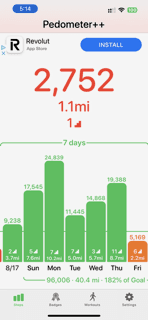Why Walking 40 Miles in One Week in Europe Felt Normal and Why It’s Rare in the USA
Why Walking 40 Miles in One Week in Europe Felt Normal and Why It’s Rare in the USA Facebook Youtube Tiktok Instagram 40 Miles in one Week? During my recent adventure in Europe, I walked an astonishing 40+ miles in just one week, exploring vibrant cities like Amsterdam, The…
Why Walking 40 Miles in One Week in Europe Felt Normal and Why It's Rare in the USA
40 Miles in one Week?
During my recent adventure in Europe, I walked an astonishing 40+ miles in just one week, exploring vibrant cities like Amsterdam, The Hague, Zuid, Utrecht, Leiden, Haarlem, and the Bijlmer Area. This level of physical activity might seem excessive for many, especially if you’re from the United States, where car culture is dominant, and daily life often involves minimal walking.
This journey across various Dutch cities offered me not just an opportunity to explore but also to reflect on the stark differences in lifestyle between Europe and the USA, particularly regarding health and physical activity.
I Love to Walk
Walking is one of my favorite ways to learn a new city because it allows me to immerse myself fully in its environment. There’s something special about the “boots on the ground” philosophy; it’s about more than just getting from one place to another. By walking, I can engage directly with the pulse of the city, hearing the languages spoken by its people, observing customs in action, and experiencing the culture firsthand. It’s a sensory experience that driving or taking public transport simply can’t provide.
Whether it’s wandering through Amsterdam’s narrow streets or strolling through the parks in Utrecht, walking allows me to connect deeply with each place I visit. It’s been a consistent approach for me across all the cities I’ve explored, and it remains the most authentic way to truly understand and appreciate a new city.
Now, I also take other forms to transportation too, like Bolt, local trains etc.
Exploring Europe on Foot: A Journey Through Dutch Cities
Walking is one of the best ways to explore European cities, and the Netherlands is no exception. With its pedestrian-friendly streets, compact city layouts, and extensive public transport networks, walking becomes a natural part of daily life. Here’s a brief overview of my adventures:
Amsterdam: I explored Amsterdam three times during my trip. The city is a maze of canals, narrow streets, and quaint bridges, perfect for wandering on foot. From the bustling Dam Square to the serene Vondelpark and the eclectic Jordaan district, every corner of Amsterdam offers something unique to discover. Walking here is both a necessity and a joy, allowing you to take in the architecture, people-watch, and stumble upon hidden gems.
The Hague: Known for its stately buildings and international institutions, The Hague was another city where I clocked in several miles. The walk from the city center to Scheveningen Beach was particularly memorable, blending urban landscapes with natural beauty.
Zuid and Bijlmer Area: These areas offered a different perspective of Dutch life. Zuid, with its blend of modern architecture and leafy neighborhoods, was a pleasure to explore on foot. The Bijlmer Area, often considered the melting pot of Amsterdam, provided a vibrant mix of cultures and communities.
Utrecht, Leiden, and Haarlem: These cities, each with its own unique charm, were perfect for walking. Utrecht’s Dom Tower, Leiden’s historic university district, and Haarlem’s cobbled streets all made for enjoyable, lengthy strolls that added up quickly.
Why Walking 40 Miles in a Week is Absurd for Many Americans
In the USA, walking 40 miles in a week might seem extraordinary, even excessive. The reasons for this are deeply rooted in cultural, urban planning, and lifestyle differences:
Car-Dependent Culture: In many parts of the United States, cars are the primary mode of transportation. Suburbs and cities are often designed with drivers in mind, with sprawling layouts and wide roads that make walking not just impractical but sometimes impossible. Even short distances are often covered by car due to a lack of pedestrian infrastructure, such as sidewalks or safe crossings.
Urban Planning: European cities, especially those in the Netherlands, are designed to be compact and walkable. Many of these cities were built long before the advent of cars, which means they are designed for pedestrians. In contrast, American cities often prioritize space for vehicles over pedestrians, making long walks less feasible or enjoyable.
Lifestyle and Work Culture: In the USA, longer work hours and a reliance on convenience-oriented lifestyles contribute to less physical activity. Many people drive from home to work, to the gym, and back home, with little walking involved in their daily routines. In contrast, European lifestyles often incorporate more walking as a natural part of daily life, whether it’s commuting by public transport, walking to shops, or enjoying leisure time in public parks.
Health Perceptions: In the USA, physical activity is often seen as something that must be scheduled—a trip to the gym, a run in the park—rather than a natural part of daily living. In Europe, walking and cycling are seamlessly integrated into everyday life, contributing to overall fitness without the need for additional exercise plans.
| Country | Cities |
|---|---|
| Estonia | Tallinn, Tartu |
| Latvia | Riga, Liepaja |
| Lithuania | Vilnius, Kaunas, Klaipeda |
| Poland | Warsaw, Krakow, Gdansk, Poznan, Wroclaw |
| Sweden | Stockholm, Gothenburg, Malmö |
| Germany | Berlin, Munich, Hamburg |
| Netherlands | Amsterdam, The Hague, Rotterdam, Utrecht |
| France | Paris, Lyon, Marseille |
| United Kingdom | London, Birmingham, Manchester |
| Portugal | Lisbon, Porto |
| Spain | Madrid, Barcelona, Valencia |
| Italy | Rome, Milan |
| Ukraine | Kyiv, Lviv, Odessa |
| Romania | Bucharest, Cluj-Napoca, Timișoara |
| Czech Republic | Prague, Brno |
| South Africa | Cape Town, Johannesburg, Durban |
| Nigeria | Lagos, Abuja |
| Ghana | Accra, Kumasi |
| Kenya | Nairobi, Mombasa |
| Uganda | Kampala |
| Tanzania | Dar es Salaam |
| Georgia | Tbilisi |
| Azerbaijan | Baku |
| Kazakhstan | Almaty |
Why Europeans Are Generally Healthier
The differences in walking habits are just one example of how European and American lifestyles diverge, particularly concerning health and wellness. Here’s why Europeans tend to be healthier:
Active Transportation: Europeans often rely on walking, cycling, and public transportation to get around. This not only increases daily physical activity but also reduces the reliance on cars. For example, many Dutch cities have extensive bike lanes, and cycling is a primary mode of transport for people of all ages. The built environment encourages physical activity as a part of everyday life.
Portion Sizes and Diet: Diet also plays a crucial role in health differences. European portion sizes are typically smaller than those in the USA, and meals often consist of fresher, less processed ingredients. In many European cultures, meals are a social experience meant to be enjoyed slowly, contributing to better digestion and satiety.
Work-Life Balance: European work culture often emphasizes a better work-life balance compared to the USA. With more vacation time and shorter work hours, Europeans have more opportunities to engage in physical activities and prioritize their health. This balance reduces stress, which is a significant factor in overall health.
Public Health Policies: European countries often have stronger public health policies and infrastructure that promote physical activity. For example, city planning that includes green spaces, pedestrian zones, and cycling infrastructure makes it easier for people to incorporate physical activity into their daily routines.
Healthcare Systems: With universal healthcare in many European countries, there is a greater emphasis on preventive care and regular health check-ups, which helps maintain overall public health.
Reflections on Walking and Health
Walking 40 miles in a week was not just an exercise in endurance; it was a reflection of a lifestyle that integrates movement into daily life naturally and enjoyably. It highlighted the stark contrast between European and American approaches to transportation, urban planning, and lifestyle.
While it might seem absurd from an American perspective to walk so much, in Europe, it’s just part of how people live their lives—actively, healthily, and often without even thinking about it. This trip was a reminder that incorporating more walking into daily life can be a simple yet effective way to improve health and well-being, no matter where you live.
As I journeyed through these Dutch cities, I couldn’t help but wonder how adopting some aspects of the European lifestyle could benefit people back in the States. Perhaps it starts with something as simple as taking that extra walk, choosing the stairs, or opting for a bike ride instead of a drive. After all, the health benefits of these small changes can add up quickly—maybe even to 40 miles in a week!

Side Note: It looks like I also climbed about 35 flight of stairs. I think most of these were going in and out of train stations!
I didn’t feel winded with all this walking, I didn’t feel like I had to walk a certain mileage or steps per day. I simply just walked and went about my day “as normal” and couldn’t believe how the steps added up quick.
When I want to Barcelona the same thing happened. One week I topped over 43 miles as well just going about my day as normal. Has this happened to you? Drop a comment and share your experience!
40 miles 40 miles 40 miles 40 miles 40 miles 40 miles 40 miles 40 miles 40 miles 40 miles 40 miles 40 miles 40 miles







